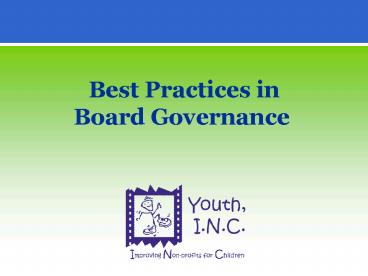Best Practices in Board Governance - PowerPoint PPT Presentation
1 / 18
Title:
Best Practices in Board Governance
Description:
Board Roles and Responsibilities. Top Five Attributes of a Quality Board ... perhaps by devoting extra energy to a single task, such as a capital campaign, ... – PowerPoint PPT presentation
Number of Views:81
Avg rating:3.0/5.0
Title: Best Practices in Board Governance
1
Best Practices in Board Governance
2
Board Governance
- Board Roles and Responsibilities
- Top Five Attributes of a Quality Board
- Top Five Best Practices in Board Governance
3
Why?
- Have a Board?
- Do people join Boards?
4
Board Roles and Responsibilities
- The non-profit Board sets the direction of the
organization, ensures resources, and provides
oversight
5
Board Roles and Responsibilities
Basic Responsibilities of a Nonprofit Board
- 1. Determine the organizations mission and
purposes - 2. Select the Executive Director
- 3. Support the E.D. and review his/her
performance - 4. Ensure effective organizational planning
- 5. Ensure adequate resources
- 6. Manage resources effectively
- 7. Be an ambassador for the organization
- 8. Assess its own performance
- Source National Center for Non-Profit Boards
6
Individual Board Member Responsibilities
- Be informed
- Participate
- Contribute financially
- Raise funds
- Be an ambassador
7
Top Five Attributes of a Quality Board
- Attribute 1 Board members have a basic
understanding of the organizations vision,
mission, operations and history - Attribute 2 The Board has a clear understanding
of the organizations primary beneficiaries and
the Boards responsibility to them as moral
owners of the organization
8
Top Five Attributes of a Quality Board
Attribute 3 Board members ensure adequate
resources for the long term Attribute 4 The
work of the Board is well organized and
managed
9
Top Five Attributes of a Quality Board
- Attribute 5 The role of the Board is clear and
distinct from the role of the staff - Board Governance
- Staff Management
10
Top Five Best Practices in Board Governance
- What should you actually do?
11
Top Five Best Practices in Board Governance
- Focus
- Build knowledge
- Promote honest, open dialogue
- Formally evaluate performance
- Insist on good practices
12
Top Five Best Practices in Board Governance
- Focus on what matters most
- Preserving the mission
- Organizational Quality
- Financial strength
- Strategy and vision
13
Top Five Best Practices in Board Governance
- 2. Build a deep knowledge of the organization
- Visit the program site(s)
- Meet people from throughout the organization
- Ask for regular reports on program results
- Stay current
14
Top Five Best Practices in Board Governance
- 3. Promote honest, open dialogue
- Involve everyone
- Ask tough questions
- Ask dumb questions
- Have the courage to disagree
- Listen to your colleagues
15
Top Five Best Practices in Board Governance
- 4. Formally evaluate performance
- Organization as a whole
- Executive Director
- Board as a whole
- Operations following strategic plan
16
Top Five Best Practices in Board Governance
- 5. Insist on good practices
- Early setting of Board calendar
- Regular rhythm to agendas
- Adequate advance materials
- Good meeting management
- Plain language/clear communication
17
Top Five Best Practices in Board Governance
- Good boards, well aware that they lack the time
and resources to tackle all of their
responsibilities at once, manage to adapt
perhaps by devoting extra energy to a single
task, such as a capital campaign, before moving
on to the next challenge. - Paul J. Jansen and Andrea R. Kilpatrick
- The McKinsey Quarterly
18
Sources
- www.nonprofits.about.com
- Strategic Board Recruitment by Robert W. Kile and
J. Michael Loscavio, Aspen, 1996 - The Board Building Cycle by Sandra Hughes, Berit
M. Lakey and Marla J. Bobowick, National Center
for Non Profit Boards, 2000 - The Chief Executives Role in Developing the
Nonprofit Board by Nancy R. Axelrod, National
Center for Nonprofit Boards, 1988 - Non Profit Board Answer Book by Robert C.
Andringa and Ted W. Engstrom, Board Source, 2002 - Jack Huston, Colgate-Palmolive































